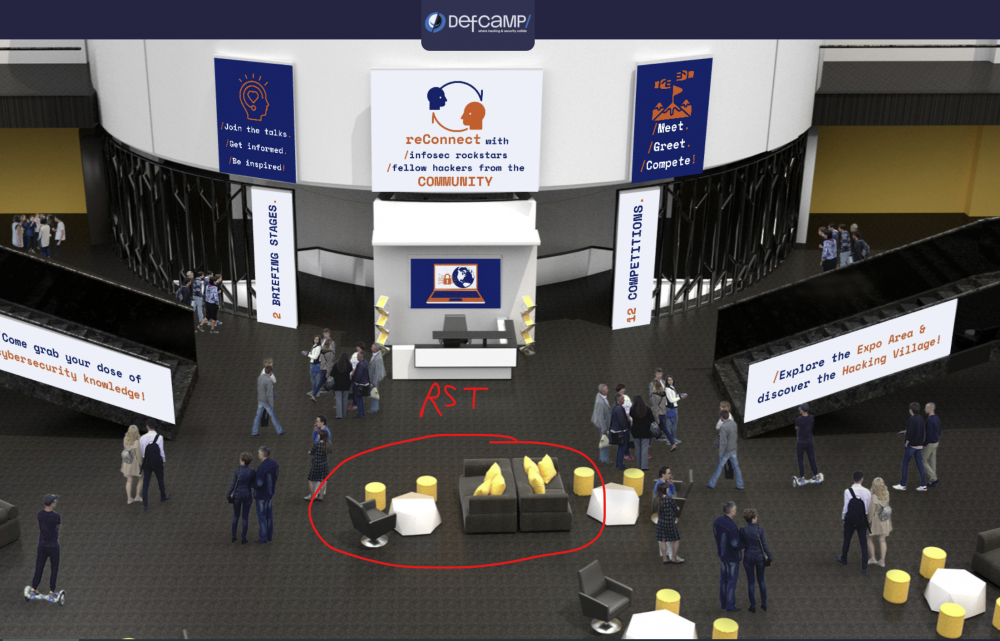-
Posts
18777 -
Joined
-
Last visited
-
Days Won
734
Everything posted by Nytro
-

It’s ON. Registration for DefCamp 2021 is OPEN
Nytro replied to Nytro's topic in Anunturi importante
Pare ok platforma aia, dar tot apar probleme. Era mai frumos cand stateam toti afara si inghetam ca niste carnati. -

It’s ON. Registration for DefCamp 2021 is OPEN
Nytro replied to Nytro's topic in Anunturi importante
-
Mai sunt si alte probleme la template, precum iconite uriase cand tii mouse-ul peste un user: I-am facut update recent dar se pare ca nu le-au fixat. Nu sunt chiar atat de naspa si nu am chef sa ma chinui iar sa repar astfel de probleme, e mai greu decat pare
-

It’s ON. Registration for DefCamp 2021 is OPEN
Nytro replied to Nytro's topic in Anunturi importante
Saptamana viitoare e Defcampu'. Deci, mergem undeva la o terasa? -
Eu fac bunnyhop la CS:GO si am sanse mari sa ma feresc de asa ceva.
-
Parca era *ri# la inceput dar nu am mai testat de multi ani.
-
Am vazut si eu cateva reduceri reale. Nu foarte mari, dar reale.
-
Catalog emag: https://gadget.ro/catalogul-emag-pentru-black-friday-2021/ Pareri?
-

It’s ON. Registration for DefCamp 2021 is OPEN
Nytro replied to Nytro's topic in Anunturi importante
Ne strangem undeva sa bem si sa facem streaming? Conditia ar fi sa avem toti bilete. @Andrei ? -

It’s ON. Registration for DefCamp 2021 is OPEN
Nytro replied to Nytro's topic in Anunturi importante
Scade numarul de cazuri, nu se face ceva si fizic? -
Mai degraba vorbesti prin spitale daca e vorba de asa ceva...
-
Salut, mie mi se pare o mare porcarie. Intr-adevar, poate ai sanse mai mari acolo sa gasesti cine stie ce droguri sau alte porcarii, dar in afara de asta nu e util la nimic. Astept si eu niste pareri diferite, poate ma insel. Referitor la "hacking", am gasit doar mizerii de acum 30 de ani parca scrise de copii de 12 ani in pauzele de la CS:GO.
-

It’s ON. Registration for DefCamp 2021 is OPEN
Nytro replied to Nytro's topic in Anunturi importante
Am putea inchiria un bar ceva, cu TV, facem stream de acolo si bem. -

It’s ON. Registration for DefCamp 2021 is OPEN
Nytro replied to Nytro's topic in Anunturi importante
DefCamp 2021 will move fully ONLINE https://def.camp/defcamp-2021-will-move-fully-online/ -
Sunt vaccinat si nu am patit nimic. M-am vaccinat deoarece am decompilat vaccinul in IDA Pro si am vazut ce contine. Deschide un port pentru bere si ruleaza un shellcode obfuscat pentru dorinta de a bea. Din analiza statica heuristica realizata peste ARN-ul mesager putem banui ca firma Corona se afla in spatele acestui vaccin.
-
Lume se pare ca este, activitate nu atat de multa. Nici eu nu am mai fost atat de activ, viata asta reala e plina de lucruri care trebuie facute...
-
Eu am dezvoltat un bruteforcer cuantic care ruleaza pe blockchain si foloseste artificial intelligence ca sa obtina acces la servere de pe glob. E privat. Din fericire nu trebuie compilat, e scris in PHP.
-
Poate s-au facut milioane de dolari cu acele scannere si nu stim noi.
-
Dap, era si el pe aici.
-
E underground, asteapta momentul potrivit sa se razbune!
-
Ar fi frumos sa strangem undeva astfel de amintiri.
-
Nu stiu daca sunt publice pe undeva. Dar am vazut pe Rise primul roman: Robert Negoita.
-
==Phrack Inc.== Volume 0x10, Issue 0x46, Phile #0x01 of 0x0f |=-----------------------------------------------------------------------=| |=-------------------------=[ Introduction ]=----------------------------=| |=-----------------------------------------------------------------------=| |=----------------------=[ Phrack Staff ]=-------------------------=| |=-----------------------=[ staff@phrack.org ]=--------------------------=| |=-----------------------------------------------------------------------=| |=-----------------------[ October 5, 2021 ]=-------------------------=| |=-----------------------------------------------------------------------=| --[ Introduction Phrack! We're back! It was only five years ago that issue 0x45 was released. It may sound bad, but it is also, indeed, quite bad. Issue 0x45 was released four years after issue 0x44. And we are now five years after that. Just trying to set the context here. The world is so different and so many things have happened in these five years that it makes no sense trying to make any point. Phrack has always been a reflection of the hacking community, and guess what, the community is moving away from itself. By this we don't mean that there are no talented hackers, because there most definitely are (just take a look at our authors). We also don't mean that there is no exquisite public hacking, because there is (again, our articles as proof). However, there is a clear move away from the collective hacking mindset that was most prevalent in the past. The word "scene" brings only smirks to people's faces. There are many reasons for this, and we are all to blame [1]. So where is the community right now, and, most importantly, where is it going? We are all ego-driven, more so nowadays we would argue, and this has definitely made collectives much harder to thrive. We expect direct payback from our hacking, in many forms, including reputation. While it was quite common to receive anonymous papers, in the past five years we got almost none. Where is the new Malloc Maleficarum? Quality isn't the question here, we have high quality hacking, we covered that. The question is about the community and how it has changed in the last 10-15 years. And about Phrack. Phrack started as a community zine of exchanging technical information and hacking techniques in a time that it was hard to find it. It later changed. It became a symbol of achievement, eliteness, and honor to be published in Phrack. A slight but significant change happened afterwards. Phrack gravitated (willingly or not is the subject of another discussion) towards an academic medium. Academia noticed the high quality of Phrack papers, started citing them, and basing their offensive and defensive work on them. Did that alienate the underground that Phrack represented for so many years? Yes, we think it did. But the underground also changed. Some of it became involved in malware, spyware, and also the "infosec" industry. And this mutated the underground. Of course we don't judge. Shouldn't Phrack be the reflection of the community, whatever the community is? Or should Phrack be a beacon of the old school underground? Well, it remains to be seen. Phrack will always be alive as long as the community is alive, reflecting it. If the hacking community becomes "infosec" in its majority, then probably so will Phrack. If the heart of the community is CTF, Phrack will reflect that. If the community focuses on malware, so will Phrack. Isn't that what Phrack has always done? It always was and always will be "by the community, for the community". If the community has decided that Phrack has a five year release cycle, then that's where we are. Unfortunately, this issue is again an issue of eulogies; we have lost hackers that have had an enormous impact on our community. Phrack would like to say goodbye to them. Their loss saddens us deeply, and makes our community poorer in talent, ethics, and intellect. We also mourn lost communities. Segfault.net has been our home/hosting in the past and is now gone. But we also have some good news! You might have come across Phrack merchandise [2], well, yes, we have resurrected it! The original 2003 art work has been found on a backup drive. All profits go to the Electronic Frontier Foundation. The EFF is a rare example of good and simple advise for the ordinary citizens. Plus a defender of our rights online and of the freedom of information. A beacon of light to say the least. The EFF used to run one of the three FTP servers to download Phrack as well. And let's not forget that the EFF paid for the attorney of Phrack's co-founder Knight Lightning in the 1990 court case and supported him all the way. They defended against the US Secret Service, a ruthless adversary with no respect for the freedom of information or the hacking scene in general. With EFF's help the case against Knight Lighting collapsed and the US Secret Service looked like a pissed on poodle. The merchandise has the Phrack Gnome on the front and the Hacker's Manifesto on the back. And ships worldwide. [1] http://www.phrack.org/issues/69/6.html [2] https://phrack.myspreadshop.co.uk/ $ cat p70/index.txt --[ Table of contents 0x01 Introduction ........................................ Phrack Staff 0x02 Phrack Prophile on xerub ............................ Phrack Staff 0x03 Attacking JavaScript Engines: A case study of JavaScriptCore and CVE-2016-4622 .................... saelo 0x04 Cyber Grand Shellphish .............................. Team Shellphish 0x05 VM escape - QEMU Case Study ......................... Mehdi Talbi & Paul Fariello 0x06 .NET Instrumentation via MSIL bytecode injection .... Antonio 's4tan' Parata 0x07 Twenty years of Escaping the Java Sandbox ........... Ieu Eauvidoum & disk noise 0x08 Viewer Discretion Advised: (De)coding an iOS Kernel Vulnerability ................................ Adam Donenfeld 0x09 Exploiting Logic Bugs in JavaScript JIT Engines ..... saelo 0x0a Hypervisor Necromancy; Reanimating Kernel Protectors .......................................... Aris Thallas 0x0b Tale of two hypervisor bugs - Escaping from FreeBSD bhyve ....................................... Reno Robert 0x0c The Bear in the Arena ............................... xerub 0x0d Exploiting a Format String Bug in Solaris CDE ....... Marco Ivaldi 0x0e Segfault.net eulogy ................................. skyper 0x0f YouTube Security Scene .............................. LiveOverflow --[ Greetz - dakami: pure passion for hacking, will be greatly missed - navs: our condolences for this brilliant hacker - accepted authors: thanks for your work, you keep Phrack alive - rejected authors: we hope our reviews helped you in some way - past Phrack Staff members: now we know ;) --[ Phrack policy phrack:~# head -77 /usr/include/std-disclaimer.h /* * All information in Phrack Magazine is, to the best of the ability of * the editors and contributors, truthful and accurate. When possible, * all facts are checked, all code is compiled. However, we are not * omniscient (hell, we don't even get paid). It is entirely possible * something contained within this publication is incorrect in some way. * If this is the case, please drop us some email so that we can correct * it in a future issue. * * * Also, keep in mind that Phrack Magazine accepts no responsibility for * the entirely stupid (or illegal) things people may do with the * information contained herein. Phrack is a compendium of knowledge, * wisdom, wit, and sass. We neither advocate, condone nor participate * in any sort of illicit behavior. But we will sit back and watch. * * * Lastly, it bears mentioning that the opinions that may be expressed in * the articles of Phrack Magazine are intellectual property of their * authors. * These opinions do not necessarily represent those of the Phrack Staff. */ ----( Contact )---- < Editors : staff[at]phrack{dot}org > > Submissions : staff[at]phrack{dot}org < Submissions may be encrypted with the following PGP key: (Hint #1: Always use the PGP key from the latest issue) (Hint #2: ANTISPAM in the subject or face the mighty /dev/null demon) Link: http://www.phrack.org/issues/70/1.html#article ❤️
-
- 1
-

-
E interesant ce se intampla, pacat ca nu prea sunt romani. De fapt e si evident: ai nostri o fac pe fata ca la ANAF sunt oamenii lor. No fucks given.




